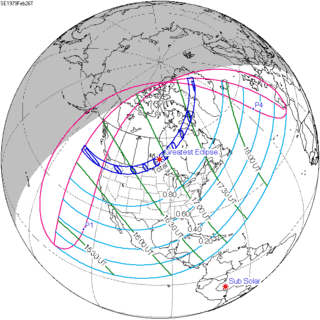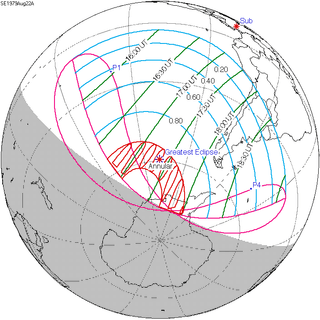Solar eclipse of February 4, 1981
| Solar eclipse of February 4, 1981 | |
|---|---|
 Map | |
| Type of eclipse | |
| Nature | Annular |
| Gamma | -0.4838 |
| Magnitude | 0.9937 |
| Maximum eclipse | |
| Duration | 33 sec (0 m 33 s) |
| Coordinates | 44°24′S 140°48′W / 44.4°S 140.8°W |
| Max. width of band | 25 km (16 mi) |
| Times (UTC) | |
| Greatest eclipse | 22:09:24 |
| References | |
| Saros | 140 (27 of 71) |
| Catalog # (SE5000) | 9466 |
An annular solar eclipse occurred on February 4–5, 1981. A solar eclipse occurs when the Moon passes between Earth and the Sun, thereby totally or partly obscuring the image of the Sun for a viewer on Earth. An annular solar eclipse occurs when the Moon's apparent diameter is smaller than the Sun's, blocking most of the Sun's light and causing the Sun to look like an annulus (ring). An annular eclipse appears as a partial eclipse over a region of the Earth thousands of kilometres wide. It was visible in Australia, crossing over Tasmania near sunrise on February 5th, and ended at sunset over western South America.
Related eclipses
Solar eclipses of 1979-1982
Each member in a semester series of solar eclipses repeats approximately every 177 days and 4 hours (a semester) at alternating nodes of the Moon's orbit.
| Descending node | Ascending node | |||||
|---|---|---|---|---|---|---|
| Saros | Map | Saros | Map | |||
| 120 |  February 26, 1979 Total |
125 |  August 22, 1979 Annular | |||
| 130 |  February 16, 1980 Total |
135 |  August 10, 1980 Annular | |||
| 140 |  February 4, 1981 Annular |
145 |  July 31, 1981 Total | |||
| 150 |  January 25, 1982 Partial |
155 |  July 20, 1982 Partial | |||
| Partial solar eclipses on June 21, 1982 and December 15, 1982 occur in the next lunar year eclipse set. | ||||||
Notes
References
- Earth visibility chart and eclipse statistics Eclipse Predictions by Fred Espenak, NASA/GSFC
- Annular Solar Eclipse Observed for Solar Radius Determination Observed from Tasmania, by Fiala, A. D., Herald, D., & Dunham, D. W, Bulletin of the American Astronomical Society, Vol. 13, p. 552
- Correcting predictions of solar eclipse contact times for the effects of lunar limb irregularities Observations from Tasmania by Herald, D. Journal of the British Astronomical Association, vol.93, no.6, p. 241-246
| Wikimedia Commons has media related to Solar eclipse of 1981 February 4. |
